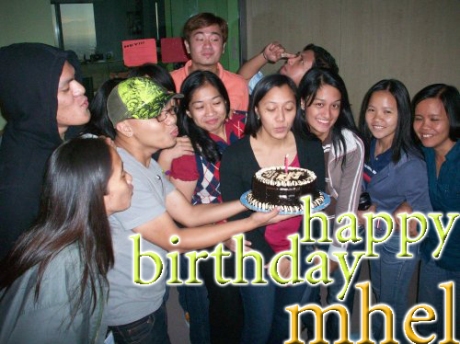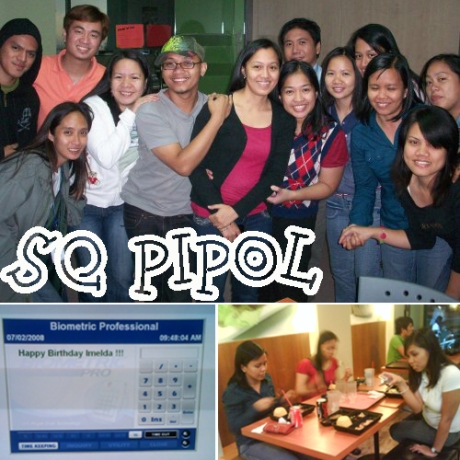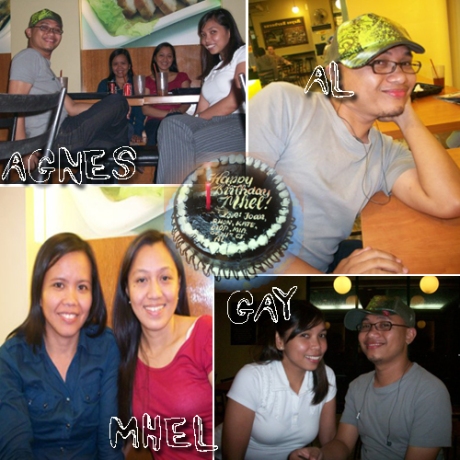> whaT's wiTh the bLow?
Author: aLmich
I’ve always been fascinated by this practice. As most people know, it is a tradition in many parts of the world to bake up a birthday cake for a friend or family member celebrating a birthday. Typically this cake is decorated nicely and topped with birthday candles, one for every year of the celebrant’s life. When the time comes to eat the cake, there is a tradition that the candles are lit and the birthday boy or girl makes a silent wish and then blows out the candles. If they are successful in their comedic [and sometimes spittled] extinguishing, it is said that the wish that they made will come true within the year.
Well, as with most things, there is more here than meets the eye. I was browsing some of my pictures when I saw those that were taken during Mhel’s birthday. It’s a funny picture with all of us helping her blow her birthday candles. It was then I asked - “What’s with the blowing”?
Good thing there’s always Google Loo to help me. It was something like this:
The blowing out of the candles on the birthday cake originated from an early tradition that believed that the smoke from the candles would take one’s wish or petition up to God.
Of course, such a tradition fits squarely within many other religious incense beliefs around the world, which we’ve briefly visited before here, here and here. The beliefs are that burning incense, a form of candle which often produces a fragrance or aroma, is a spiritual purificatory rite that has any number of benefits:
practical use [obscure odor, particularly in funerary ceremonies to cover the scent of decay]
chronological measurement
repel mosquitoes or other insects [Zen Buddhists use this technique when meditating]
indulgence for the sense of smell
sacrificial offering to deity
It is in this final sense that we find most usage in the Judeo-Christian tradition, and in the Bible. Our Bible Dictionary teaches:The preparation of incense is described in Ex. 30:34-36; the duty of offering it twice daily fell upon the high priest (Ex. 30:7-8), but in the second temple the privilege was extended to all the priests, and the lot was cast each day to decide who should offer (Luke 1:9). Live coals were brought from the brazen altar of burnt offering, and placed on the golden altar of incense; then the priest to whom the lot had fallen entered alone into the Holy Place, carrying in a censer the incense, which he cast on the fire. Then, bowing reverently toward the Holy of Holies, he returned to the congregation, who were praying outside, and pronounced the blessing in Num. 6:24-26. The choir of Levites at once started to sing the daily psalms. On the Day of Atonement there was a special offering of incense. See Rev. 5:8; Rev. 8:3-4; cf. Ps. 141:2; Mal. 1:11.1
Such an offering of incense by the priests gathered around altars set before the veil in the tabernacle or temple was believed to carry the prayers of the Israelites as smoke up to the throne of God, such that they would be heard by Jehovah more effectively.
Let my prayer be set forth before thee as incense; and the lifting up of my hands as the evening sacrifice. (Ps. 141:2)
So there. At least we know now “what’s with the blow”.
Something to keep in mind the next time you are blowing out your birthday candles.
These photos were all from that day. Kulit no?
Again, Happy Birtday Mhel!!!
From :
Gay, Kate, Jill. Rhon, Agnes, Al, Cj, Joanne, Dior, Mia, Genie, Princess, Ryan, Aiah



 This Blog is an outlet for the random thoughts of an amateur opinionator.
What's an opinionator?
An opinionator is somebody who has power without responsibility, and the ability to spout off on any subject without worrying too much about the consequences of what comes out of the mouth. All you need is an opinion and the opportunity to voice it.
TV is full of professional opinionators. The internet gives the amateur his chance.
This Blog is an outlet for the random thoughts of an amateur opinionator.
What's an opinionator?
An opinionator is somebody who has power without responsibility, and the ability to spout off on any subject without worrying too much about the consequences of what comes out of the mouth. All you need is an opinion and the opportunity to voice it.
TV is full of professional opinionators. The internet gives the amateur his chance.




